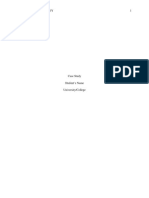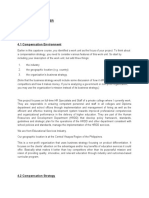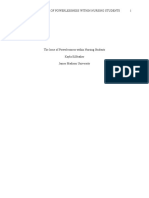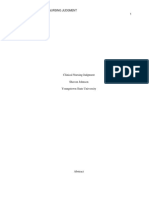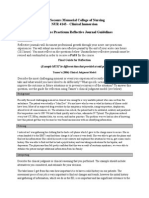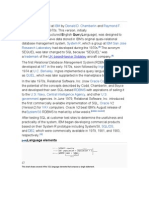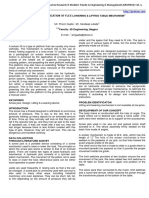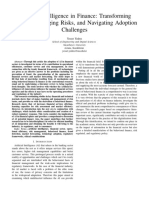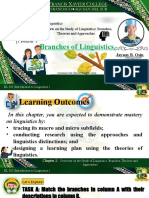Ethics Paper Final
Ethics Paper Final
Uploaded by
api-308162223Copyright:
Available Formats
Ethics Paper Final
Ethics Paper Final
Uploaded by
api-308162223Original Title
Copyright
Available Formats
Share this document
Did you find this document useful?
Is this content inappropriate?
Copyright:
Available Formats
Ethics Paper Final
Ethics Paper Final
Uploaded by
api-308162223Copyright:
Available Formats
Running head: BRIDGE TO PRACTICE ETHICS PAPER
Bridge to Practice Ethics Paper
Katelyn R. Bryce
James Madison University
BRIDGE TO PRACTICE ETHICS PAPER
INTRODUCTION:
Maltreatment of the elderly population in long-term care facilities is a serious issue
commonly overlooked. As many as 2.5 million older people are abused in some form each year
and this number will only continue to grow as the elderly population does too (Kleinschmidt,
1997). It is associated with an increased rate of morbidity and mortality in patients that reside in
long-term facilities. There are various types of elder mistreatment including neglect and physical,
psychological, financial, and sexual abuse, all of which occur in nursing homes, residential care
facilities, and assisted living facilities (Gibbs & Mosqueda, 2004). Sadly enough, most elderly
abuse cases go unreported. Surveys conducted in Boston showed that only 1 out of every 14
cases were reported. As of today, all states have laws mandating the report of suspicion of elder
abuse. However, mandatory reporting of elder abuse brings about various ethical conflicts.
(Kleinschmidt, 1997)
BACKGROUND:
During my very first clinical experience at a long-term care facility for the elderly, I came
across an ethical situation. I was assigned a 98-year-old female patient and was told to follow the
CNA whose care the patient was under. The first incident occurred while the CNA and I were
changing and bathing my patient. During the process, I watched the CNA pretty much throw the
patient over on her bad side; the patient had a weak left arm and leg. The patient also had a
sore left breast that needed to be taken care of gently and required extra care because of a rash.
However, the CNA disregarded this and wiped her roughly even after the patient had nicely
asked her if she could be careful with her left breast because it was very tender and had
expressed the pain she was putting her through. The CNA rudely responded demanding that the
patient was fine and ordered her to quit her whining. A second incident occurred after putting the
BRIDGE TO PRACTICE ETHICS PAPER
patient in her wheelchair. The CNA attempted to brush her teeth but did so in a very rough
manner, practically choking the patient with her own toothbrush causing the patient to gag
multiple times. During lunch, the patient informed me that she was very hungry because the
CNA had neglected to feed her breakfast. Having known the correct way and skills needed in
caring for a patient, as learned in lab, I came to the conclusion that I needed to do something
about the way the CNA was treating my patient. I felt responsible for my patient as well and
could not continue to watch her being treated so terribly. At the end of the day, I brought my
concerns up to my clinical instructor. I told her everything I had witnessed and who the CNA
was. I was completely unsure of what exactly I should do about it and wanted to put it into her
hands. She told me that I had done the right thing in coming to her and that she would talk to the
charge nurse about it and handle it from that point forward. An alternative response to the
situation would be to go straight to the charge nurse with my clinical instructor. I think it would
have helped if the charge nurse heard the story straight from me that way I could be there if any
problems occurred.
This day had created a situation of moral distress for me. In this situation, I knew what
the right thing to do was and how to correctly treat a patient. However, I felt powerless and felt
as if I could not stand up to the CNA and speak my mind. I was not torn between two ethically
wrong decisions to make; I just needed the confidence and power to do the right thing.
METHOD:
The JMU 8 Key Questions can be used to help evaluate ethical situations. Fairness
involves the questioning of equal and just treatment while outcomes encompasses both the short
and long-term consequences of the patient and/or provider (Alger & Sternberger, 2013). The
correlation between responsibility and rights is considered because when one person has a
BRIDGE TO PRACTICE ETHICS PAPER
responsibility or duty another person has a right. Character includes questioning ones best self
and determining what virtues to maintain or eliminate. Empathy embraces these positive virtues
and allows one to respond as if they deeply felt for the person. Liberty includes the respect of
ones decisions, actions, and the person as a whole also including ones confidentiality and
consent. The last key question, authority, involves the evaluation of what is expected of an
individual by legitimate authorities often resulting in successful outcomes.
FINDINGS:
Fairness became an issue in this ethical situation when the CNA neglected to consider the
patients dignity. The CNAs overall attitude was one that, in general, did not include fairness
when taking care of her assigned patients. The situation could have resulted in short-term
outcomes such as direct harm to the patient, diminished self-esteem, and negative impact on
bodily care of the patient. Long-term outcomes that could have possibly resulted include further
advancement towards morbidity and mortality. Another possible long-term outcome includes the
nursing home developed a negative reputation. Responsibility is largely a key factor in this
situation because the CNA should have held full responsibility in the care of the patient. The
CNA had the responsibility of not only apologizing to the patient but also taking proper action to
make the situation just. On the other hand, the patient had the right to be responded to
appropriately which included being heard and listened to. One of the components, character, was
completely ignored by the CNA herself in deciding what the treatment of the patient would
entail. However, I evaluated my own character when I took this as a learning experience in how
not to act in the future. I realized empathy played a role in this situation when I was overcome
with a combination of sadness and anger. I empathized with not only the patient but also the
other residents when realizing that others had probably been treated in this same way before.
BRIDGE TO PRACTICE ETHICS PAPER
First and foremost, the component of patient autonomy that falls under liberty was ignored. The
patients ability to defend herself was compromised and therefore the CNA was able to take full
advantage of the patient knowing that she probably couldnt defend herself. Another aspect of
liberty, confidentiality, was involved when I felt the need to inform the patients family how she
was being treated but decided it would be better to avoid causing them more distress and
allowing the facility to handle it. In terms of authority, the CNA seemed to believe that her
authority was above mine but I didnt allow this to intimidate me. I immediately reported what I
had seen to my clinical instructor who assured me that she would further report this to the charge
nurse.
Provision 3 promotes guidance in patient care by outlining the responsibilities of us as
nurses as we serve as advocates, protectors, and promoters of rights, health, and safety of all
patients (Brown & Finnell, 2015).
CONCLUSION:
In looking back, I realized that I could have gone further and reported the incident to the
charge nurse myself. The benefit of this would have been that she would have heard my personal
account of the situation. In the future, I will still report a situation like this to my clinical
instructor if still a student nurse and then follow up with the charge nurse. If at that point I am an
RN, I will simply go to the charge nurse myself. The JMU 8 Key Questions helped me
understand how to breakdown an ethical situation. They also allowed me to consider different
approaches when making ethical decisions. When looking over Provision 3 of the ANA Code of
Ethics, I was made aware of the fact that it is our duty as nurses to protect patients in all
situations even if it involves taking actions that are challenging (Brown & Finnell, 2015).
BRIDGE TO PRACTICE ETHICS PAPER
References
Alger, J. R., Sternberger, L., & Goldstein, B. (2013). The madison collaborative: Ethical
reasoning in action Harrisonburg, Va. : James Madison University, c2013.
Brown, C., S., & Finnell, D., S. (2015). Provisions of the code of ethics for nurses: Interpretive
statements for transplant nurses. Nephrology Nursing Journal, 42(1), 37-44.
Gibbs, L. M., & Mosqueda, L. (2004). Confronting elder mistreatment in long-term care. Annals
of Long Term Care, 12(4), 30-35.
Kleinschmidt, K. C. (1997). Elder abuse: A review. Annals of Emergency Medicine, 30, 463-472.
doi:10.1016/S0196-0644(97)70006-4
You might also like
- Scenario 2. ReflectionDocument5 pagesScenario 2. ReflectionShafiq Ur Rahman50% (2)
- 76 Case StudyDocument7 pages76 Case StudyDon Fablo100% (1)
- So 2ND Ed Pin Read Extra U1Document1 pageSo 2ND Ed Pin Read Extra U1Lara Carvalho100% (1)
- Code of Ethics For NursesDocument5 pagesCode of Ethics For NursesKamran Khan100% (1)
- Rongda Enduser Manual 1Document19 pagesRongda Enduser Manual 1Anonymous WD109UakyNo ratings yet
- HRM: People Manager Coursera Milestone Week 4Document5 pagesHRM: People Manager Coursera Milestone Week 4Charmis TubilNo ratings yet
- A S PaperDocument6 pagesA S Paperapi-308398814No ratings yet
- Ethics PaperDocument6 pagesEthics Paperapi-307931906No ratings yet
- Final Ethics PaperDocument6 pagesFinal Ethics Paperapi-380704330No ratings yet
- Running Head: Bridge To Practice Ethics PaperDocument6 pagesRunning Head: Bridge To Practice Ethics Paperapi-308232715No ratings yet
- Parker Ethics Paper March 24 2018 - 2Document6 pagesParker Ethics Paper March 24 2018 - 2api-391821687No ratings yet
- Lavery Ethics Paper Mar 19-1Document5 pagesLavery Ethics Paper Mar 19-1api-379147861No ratings yet
- Ethics PaperDocument6 pagesEthics Paperapi-379557456No ratings yet
- Schiefer Ethics Paper March 19Document6 pagesSchiefer Ethics Paper March 19api-340362893No ratings yet
- Ethical Decision Making PaperDocument6 pagesEthical Decision Making Paperapi-330207627No ratings yet
- Art and Science - Ethics PaperDocument6 pagesArt and Science - Ethics Paperapi-354192611No ratings yet
- Ethical PaperDocument6 pagesEthical Paperapi-307761889No ratings yet
- Kilfeather Ethics Paper Mar22Document6 pagesKilfeather Ethics Paper Mar22api-381092565No ratings yet
- Lee-Ethics Paper-3 19 18Document6 pagesLee-Ethics Paper-3 19 18api-301947262No ratings yet
- Running Head: Ethics of PresenteeismDocument6 pagesRunning Head: Ethics of Presenteeismapi-308397331No ratings yet
- Clinical Nurse Judgement CapstoneDocument6 pagesClinical Nurse Judgement Capstoneapi-591372252No ratings yet
- Mendoza Ethics Paper Mar 19Document6 pagesMendoza Ethics Paper Mar 19api-340294934No ratings yet
- Garcia Ethics Paper Mar23Document6 pagesGarcia Ethics Paper Mar23api-380848444No ratings yet
- Self-Reflection EssayDocument3 pagesSelf-Reflection EssayMarie Antonette De GuzmanNo ratings yet
- Hs 2050 This Is Me Now TemplateDocument7 pagesHs 2050 This Is Me Now Templateapi-494872599No ratings yet
- Braley Ethics Paper Final March24Document7 pagesBraley Ethics Paper Final March24api-381438480No ratings yet
- Nurs217 Scholarly AssignmentDocument8 pagesNurs217 Scholarly Assignmentapi-314700318No ratings yet
- Stoessel Ethics Paper 10 17 16Document6 pagesStoessel Ethics Paper 10 17 16api-314521377No ratings yet
- Conflict PaperDocument10 pagesConflict PapermahnumaNo ratings yet
- 2 21 23 Capstone PaperDocument6 pages2 21 23 Capstone Paperapi-655053476No ratings yet
- April Rose L. Ealdama Abdulhaq K. Dimalen John Mark D. Doruelo John Brenz Lirog DunganDocument3 pagesApril Rose L. Ealdama Abdulhaq K. Dimalen John Mark D. Doruelo John Brenz Lirog DunganRaisen EbusNo ratings yet
- Clinical Nursing Judgment RPDocument6 pagesClinical Nursing Judgment RPapi-546398486No ratings yet
- Riddiford Ethics Paper Nov17Document6 pagesRiddiford Ethics Paper Nov17api-354529854No ratings yet
- Umhafer Ethics PaperDocument6 pagesUmhafer Ethics Paperapi-444947174No ratings yet
- Presentation On Be & CGDocument10 pagesPresentation On Be & CGvivek_hooliNo ratings yet
- NLM Sas 8Document6 pagesNLM Sas 8Zzimply Tri Sha UmaliNo ratings yet
- Clinical ExemplarDocument5 pagesClinical Exemplarapi-485472556No ratings yet
- Nursing PhilosophyDocument7 pagesNursing Philosophyapi-658326842No ratings yet
- Legal and Ethical IssuesDocument22 pagesLegal and Ethical IssuesPratima Karki100% (1)
- Philosophy PaperDocument7 pagesPhilosophy Paperapi-309980971No ratings yet
- Case Study PaperDocument8 pagesCase Study Paperapi-663318600No ratings yet
- MaltreatmentDocument7 pagesMaltreatmentapi-315331895No ratings yet
- Bosley Ethics Paper Mar 7Document6 pagesBosley Ethics Paper Mar 7api-339034150No ratings yet
- Nursing EthicsDocument10 pagesNursing EthicsArdeJenniferNo ratings yet
- Arcaya - Week 4 Written AssignmentDocument2 pagesArcaya - Week 4 Written AssignmentIlert Kliene Tantoy ArcayaNo ratings yet
- Capstone Scholarly PaperDocument6 pagesCapstone Scholarly Paperapi-508292006No ratings yet
- Clinical Nursing JudgementDocument7 pagesClinical Nursing Judgementapi-453417498No ratings yet
- Reflection Paper-Ethical and Legal ConcernsDocument6 pagesReflection Paper-Ethical and Legal ConcernsLyka Mae TuyNo ratings yet
- Ethics PaperDocument7 pagesEthics Paperapi-332691684No ratings yet
- PICACHE - Reflective Journal FinalsDocument3 pagesPICACHE - Reflective Journal FinalsLeo Marie PicacheNo ratings yet
- Fayloga, John Mheldrick R. BSN II Vii Marilyn Ray Case Study 1Document3 pagesFayloga, John Mheldrick R. BSN II Vii Marilyn Ray Case Study 1john faylogaNo ratings yet
- Scholarly EssayDocument7 pagesScholarly Essayapi-284041802No ratings yet
- Two Ethics Case ScenariosDocument3 pagesTwo Ethics Case ScenariosEguia NielNo ratings yet
- Perkins Ethics Paper Mar17Document6 pagesPerkins Ethics Paper Mar17api-379819780No ratings yet
- Code of Ethics PaperDocument14 pagesCode of Ethics PaperWilliam Cifer100% (2)
- B Dailey Final Reflection (1) - 3Document2 pagesB Dailey Final Reflection (1) - 3api-283673800No ratings yet
- Code of Ethics For NursesDocument3 pagesCode of Ethics For NursesLady Mae Ramos100% (3)
- Volman Ethics Paper March19Document6 pagesVolman Ethics Paper March19api-381505333No ratings yet
- Gea2 1 1 1Document5 pagesGea2 1 1 1api-533555602No ratings yet
- New Tugas Miss VinDocument3 pagesNew Tugas Miss VinetikNo ratings yet
- Nomos Meaning "Custom" or "Law". This Reflects The Political Sense of The Word-A Group's RightDocument4 pagesNomos Meaning "Custom" or "Law". This Reflects The Political Sense of The Word-A Group's RightZoe Jisel LuzadasNo ratings yet
- Bioethics Paper 2Document7 pagesBioethics Paper 2iluv2rockNo ratings yet
- Afflicted: How Vulnerability Can Heal Medical Education and PracticeFrom EverandAfflicted: How Vulnerability Can Heal Medical Education and PracticeNo ratings yet
- Tamir AntenehDocument149 pagesTamir AntenehAmeNo ratings yet
- Term Paper: Signature of Student Signature of SupervisorDocument45 pagesTerm Paper: Signature of Student Signature of SupervisorAnjali AgrawalNo ratings yet
- IBM Donald D. Chamberlin Raymond F. Boyce: HistoryDocument16 pagesIBM Donald D. Chamberlin Raymond F. Boyce: HistorySajeesh BabuNo ratings yet
- Teaching Sequence For WritingDocument41 pagesTeaching Sequence For WritingBình Nguyễn Thị ThanhNo ratings yet
- Kia Seltos 4 Page Leaflet 2023 Desktop RevisedDocument4 pagesKia Seltos 4 Page Leaflet 2023 Desktop RevisedSathyamoorthi AnnamalaiNo ratings yet
- EF4e Elem Filetest 10b Answer KeyDocument3 pagesEF4e Elem Filetest 10b Answer KeyIslam Duishonaliev100% (1)
- 3 Organisation-Level Diagnosis (2) RevisedDocument10 pages3 Organisation-Level Diagnosis (2) RevisedRosyta Nur AzizahNo ratings yet
- G Mango Accounting Pack Model DataDocument13 pagesG Mango Accounting Pack Model DataalphabetttNo ratings yet
- Scissor LiftDocument4 pagesScissor LiftnithiNo ratings yet
- Intro To Beh. FinanceDocument35 pagesIntro To Beh. FinanceAnonymous YKmreGjNo ratings yet
- Nick James VujicicDocument6 pagesNick James VujicicWhitney RodelasNo ratings yet
- IntroductionDocument1 pageIntroductione.edres123No ratings yet
- 2000 Content Locker Niches 2024Document16 pages2000 Content Locker Niches 2024essaadiaelmasnaoui99No ratings yet
- Review & Critical Appraisal of Newborn Health Programs - DRHNDocument44 pagesReview & Critical Appraisal of Newborn Health Programs - DRHNSagar ParajuliNo ratings yet
- Tickets State of OriginDocument4 pagesTickets State of OriginSimon MckeanNo ratings yet
- Soal Bahasa InggrisDocument18 pagesSoal Bahasa InggrisDwi Rohman MusliminNo ratings yet
- Invisible ManDocument13 pagesInvisible ManRamNo ratings yet
- CS 303e, Assignment #10: Practice Reading and Fixing Code Due: Sunday, April 14, 2019 Points: 20Document2 pagesCS 303e, Assignment #10: Practice Reading and Fixing Code Due: Sunday, April 14, 2019 Points: 20Anonymous pZ2FXUycNo ratings yet
- Eddie Smith Help Your Group Pray in One AccordDocument6 pagesEddie Smith Help Your Group Pray in One AccordGin BurdaNo ratings yet
- Chapter 2 Lesson 1Document28 pagesChapter 2 Lesson 1Jee Sheone Osin IINo ratings yet
- Airbus SB A320-31-1583 R05 Dated 09.apr.2021Document240 pagesAirbus SB A320-31-1583 R05 Dated 09.apr.2021Pradeep K sNo ratings yet
- 6GD S4CLD2302 BPD en UsDocument129 pages6GD S4CLD2302 BPD en UsFurqanNo ratings yet
- Jiwaji University Coursework FormDocument8 pagesJiwaji University Coursework Formgpwefhvcf100% (2)
- Malawi Institute of Education Bid 2023Document30 pagesMalawi Institute of Education Bid 2023richardkondowe8No ratings yet
- Council of JavnehDocument4 pagesCouncil of JavnehJon100% (1)
- Speculating A Picture: FocusDocument6 pagesSpeculating A Picture: FocusThu TrangNo ratings yet
- Bai Tap Tieng Anh Lop 5 Unit 14 Nang Cao What Happened in The StoryDocument5 pagesBai Tap Tieng Anh Lop 5 Unit 14 Nang Cao What Happened in The StoryHang TranNo ratings yet

